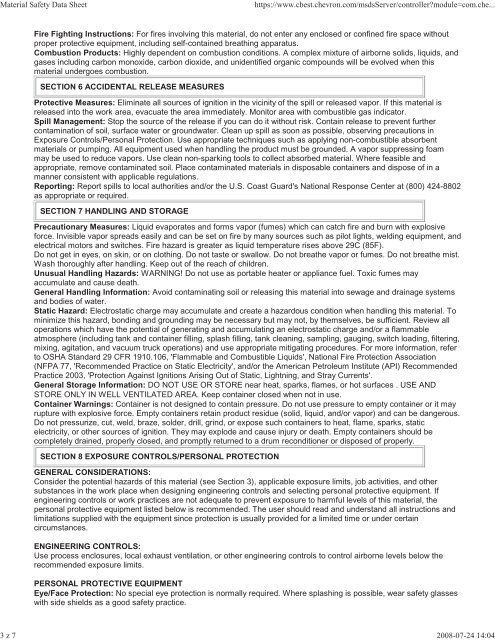Print MSDS - Miller Electric Company Publications
Print MSDS - Miller Electric Company Publications
Print MSDS - Miller Electric Company Publications
Create successful ePaper yourself
Turn your PDF publications into a flip-book with our unique Google optimized e-Paper software.
Material Safety Data Sheet https://www.cbest.chevron.com/msdsServer/controller?module=com.che...<br />
Fire Fighting Instructions: For fires involving this material, do not enter any enclosed or confined fire space without<br />
proper protective equipment, including self-contained breathing apparatus.<br />
Combustion Products: Highly dependent on combustion conditions. A complex mixture of airborne solids, liquids, and<br />
gases including carbon monoxide, carbon dioxide, and unidentified organic compounds will be evolved when this<br />
material undergoes combustion.<br />
SECTION 6 ACCIDENTAL RELEASE MEASURES<br />
Protective Measures: Eliminate all sources of ignition in the vicinity of the spill or released vapor. If this material is<br />
released into the work area, evacuate the area immediately. Monitor area with combustible gas indicator.<br />
Spill Management: Stop the source of the release if you can do it without risk. Contain release to prevent further<br />
contamination of soil, surface water or groundwater. Clean up spill as soon as possible, observing precautions in<br />
Exposure Controls/Personal Protection. Use appropriate techniques such as applying non-combustible absorbent<br />
materials or pumping. All equipment used when handling the product must be grounded. A vapor suppressing foam<br />
may be used to reduce vapors. Use clean non-sparking tools to collect absorbed material. Where feasible and<br />
appropriate, remove contaminated soil. Place contaminated materials in disposable containers and dispose of in a<br />
manner consistent with applicable regulations.<br />
Reporting: Report spills to local authorities and/or the U.S. Coast Guard's National Response Center at (800) 424-8802<br />
as appropriate or required.<br />
SECTION 7 HANDLING AND STORAGE<br />
Precautionary Measures: Liquid evaporates and forms vapor (fumes) which can catch fire and burn with explosive<br />
force. Invisible vapor spreads easily and can be set on fire by many sources such as pilot lights, welding equipment, and<br />
electrical motors and switches. Fire hazard is greater as liquid temperature rises above 29C (85F).<br />
Do not get in eyes, on skin, or on clothing. Do not taste or swallow. Do not breathe vapor or fumes. Do not breathe mist.<br />
Wash thoroughly after handling. Keep out of the reach of children.<br />
Unusual Handling Hazards: WARNING! Do not use as portable heater or appliance fuel. Toxic fumes may<br />
accumulate and cause death.<br />
General Handling Information: Avoid contaminating soil or releasing this material into sewage and drainage systems<br />
and bodies of water.<br />
Static Hazard: Electrostatic charge may accumulate and create a hazardous condition when handling this material. To<br />
minimize this hazard, bonding and grounding may be necessary but may not, by themselves, be sufficient. Review all<br />
operations which have the potential of generating and accumulating an electrostatic charge and/or a flammable<br />
atmosphere (including tank and container filling, splash filling, tank cleaning, sampling, gauging, switch loading, filtering,<br />
mixing, agitation, and vacuum truck operations) and use appropriate mitigating procedures. For more information, refer<br />
to OSHA Standard 29 CFR 1910.106, 'Flammable and Combustible Liquids', National Fire Protection Association<br />
(NFPA 77, 'Recommended Practice on Static <strong>Electric</strong>ity', and/or the American Petroleum Institute (API) Recommended<br />
Practice 2003, 'Protection Against Ignitions Arising Out of Static, Lightning, and Stray Currents'.<br />
General Storage Information: DO NOT USE OR STORE near heat, sparks, flames, or hot surfaces . USE AND<br />
STORE ONLY IN WELL VENTILATED AREA. Keep container closed when not in use.<br />
Container Warnings: Container is not designed to contain pressure. Do not use pressure to empty container or it may<br />
rupture with explosive force. Empty containers retain product residue (solid, liquid, and/or vapor) and can be dangerous.<br />
Do not pressurize, cut, weld, braze, solder, drill, grind, or expose such containers to heat, flame, sparks, static<br />
electricity, or other sources of ignition. They may explode and cause injury or death. Empty containers should be<br />
completely drained, properly closed, and promptly returned to a drum reconditioner or disposed of properly.<br />
SECTION 8 EXPOSURE CONTROLS/PERSONAL PROTECTION<br />
GENERAL CONSIDERATIONS:<br />
Consider the potential hazards of this material (see Section 3), applicable exposure limits, job activities, and other<br />
substances in the work place when designing engineering controls and selecting personal protective equipment. If<br />
engineering controls or work practices are not adequate to prevent exposure to harmful levels of this material, the<br />
personal protective equipment listed below is recommended. The user should read and understand all instructions and<br />
limitations supplied with the equipment since protection is usually provided for a limited time or under certain<br />
circumstances.<br />
ENGINEERING CONTROLS:<br />
Use process enclosures, local exhaust ventilation, or other engineering controls to control airborne levels below the<br />
recommended exposure limits.<br />
PERSONAL PROTECTIVE EQUIPMENT<br />
Eye/Face Protection: No special eye protection is normally required. Where splashing is possible, wear safety glasses<br />
with side shields as a good safety practice.<br />
3 z 7 2008-07-24 14:04



